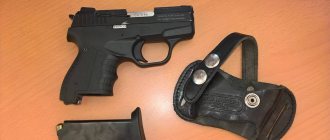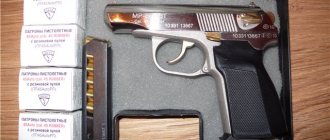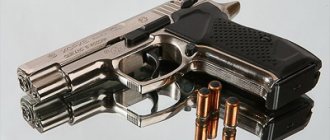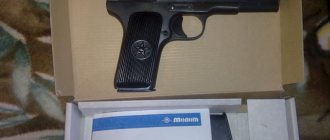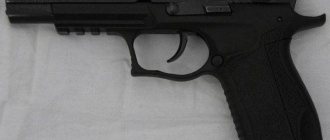The Tanfoglio company has been producing sporting pistols and self-defense weapons since approximately the mid-60s of the twentieth century. Having accumulated considerable experience, the company's engineers created a police model of a pistol called Tanfoglio Force Compact, as well as its version for firing limited-kill ammunition - Tanfoglio INNA, which will be discussed. Developed on the basis of a police model, the Inna pistol received a reliable operating mechanism, and despite its compact dimensions, quite powerful ammunition.
Tanfolio INNA has a high-strength plastic frame in which a permanent trigger mechanism and barrel are installed. The barrel in this model is made of hardened steel, which has a strength rating of 47 on the Rockwell scale and has “teeth” on the inner surface of the barrel bore.
This arrangement with cast “teeth” sometimes damages rubber bullets, but only from too soft rubber - but it effectively dampens the excessive velocity of the ammunition, minimizing the possibility of penetrating wounds.
The compact dimensions of the Tanfoglio pistol made it possible to make the control more convenient for “one-handed” use - the safety, for example, is controlled by the thumb, and the handle, despite its non-standard dimensions, is quite comfortable and a shooter with minimal qualifications will get used to it in just a week or two.
History of the pistol
Tanfoglio INNA is in a certain sense a unique pistol. Weapons can be bought in Russia only in specialized stores. It is precisely because of its uniqueness that this model is extremely popular and in constant demand among Russian consumers.
The uniqueness of this pistol is that, unlike many traumatic pistols from other manufacturing companies, Tanfoglio INNA can fire ammunition that was developed specifically for this model, and they are not made weaker, as for many similar models of traumatic pistols, but on the contrary, cartridges became much more powerful.
Thus, Tanfoglio INNA’s ammunition is not weak, but, on the contrary, the cartridges have a weighted bullet, which, accordingly, affects the lethality of these ammunition. In addition to the cartridges themselves, this model of weapon also has a uniquely made barrel, which additionally arouses great interest in the pistol.
The developer of this traumatic model is Tanfoglio (Italy). This product is basically copied from the Tanfoglio FT9 combat pistol. Since 2009, traumatika began to be sold on the territory of the Russian Federation.
The caliber of this pistol is the same as that of most other types of traumatic weapons, that is, it can fire 9 mm RA cartridges.
Barrel Features
The trunk needs to be mentioned separately. The barrel of this pistol is not solid, but composite; it has a specially installed jumper inside so that it is impossible to shoot solid bullets from the weapon. But at the same time, the size of this partition in this case is very small, and is made in such a shape that the rubber ball, passing through the barrel channel after firing, remains almost intact. No other traumatic weapon has smaller partitions than Tanfoglio.
Taking into account this feature of the barrel bore, ammunition with high penetrating power Magnum AKBS was made for this model, which was called “Magnum for INNA”, while they have the same caliber - 9 mm R.A.
Due to this design solution for making a barrel from this weapon, it is possible to fire any traumatic cartridges of the appropriate caliber.
Although, as practice shows, the most suitable ammunition for Tanfoglio is precisely the cartridge that is marked “Magnum AKBS”.
However, along with these advantages, this barrel also has some disadvantages. They consisted, again, in the installed rounded teeth in the barrel channel. When fired with reinforced cartridges, the teeth-partitions were smoothed out, penetrating into the barrel, and as a result, the latter gradually began to become almost smooth, without any inserts. Naturally, some people could find certain advantages in this, but a traumatic pistol that has a smooth barrel, so to speak, is “prohibited from existing.”
Basically, during the operation of the weapon, these partitions in the barrel were not pressed through, but only torn, so firing from this product was useless. For some time they tried to install new partitions in the barrel channel, which were of the same quality, but very quickly they also broke. As a result, the partitions in the canal began to be made cast, and this allowed for a positive effect. These inserts were no longer erased and remained intact, and so this pistol turned out to be one of the most popular traumatic weapons on the market.
If we consider the Tanfoglio INNA traumatism as a likely direction for subsequent installation in other models of pistols of this barrel design, then it is impossible to say for sure whether this direction will develop and enjoy great popularity. It’s just that from a technical point of view it is much easier to make a barrel with thick walls with small protrusions in the channel and weaken it with longitudinal crossbars; this way you can adjust the pistol to all the requirements for certification, taking into account the legislation of the Russian Federation.
At the same time, this method of manufacturing a traumatic gun barrel will be much more wear-resistant, naturally, during high-quality manufacturing, which is why it is much more attractive to consumers. In addition, with the development of more powerful ammunition, if, of course, this happens, this barrel can easily withstand these cartridges, but a barrel weakened by the crossbars will definitely begin to suffer from the use of these cartridges.
Again, if we consider the possibility of using reinforced ammunition, then it becomes necessary to install a new reinforced return spring, and it is also impossible to say that the pistol frame and bolt will withstand high loads, since these parts need to be manufactured with a fairly large margin of safety.
A review of the Tanfoglio INNA traumatic pistol can be seen in this video:
Owner reviews
“I, as they say, was “conquered” by Inna in absentia. And having bought my own, the relationship did not change. My Tanfolio from the first batch, from the first hundred, with mostly only powerful ammunition fired (AKBS Magnum and Magnum for Inna Tanfoglio) over 12,000, is alive and well, and has an appearance almost like “from a store.” Increased wear resistance and durability are Inna’s strong point. According to FRATELLI TANFOGLIO SNC, Inna’s resource is such that when shooting 25,000, only a number of springs and some trigger elements need to be replaced, and she is again ready for further trouble-free operation.
I will note the shortcomings and advantages that I noticed.
The “growing pains” of Inn’s first and second deliveries were a weak liner with “crushed teeth” that were destroyed when fired with powerful cartridges. The design of the weapon was changed, and a liner with cast “teeth” appeared in the barrel, completely solving the problem. I got used to the handle in one day, but for some it is a little short, because... There is no full rest for the little finger. Maybe INNA is a little “overweight”, it probably seems so from the habit of PM. But this is noticeable when you use a “high” belt holster; in a horizontal operational holster you forget about this dimension. In fact, I have about a dozen different holsters for Inna, depending on my mood and circumstances, and I use them all without any problems.
It’s convenient to aim, but it’s more of a habit. In my opinion, the front sight could have been made thinner, as could the slot in the rear sight. And the white dots here and there just get in the way. The excessively stiff magazine spring shook my nerves, but only for the first 2-3 weeks, but now there are no problems with the magazine equipment. Lids that are not trustworthy may soon crack. Therefore, it is better to order or make metal ones yourself. It is not very convenient to clean, especially the USM, because... Complete disassembly of the pistol is impossible. A non-chrome-plated barrel rusts and becomes quite dirty with rubber. There is only one method of control - thorough and frequent cleaning. In addition, if the barrel, chromed inside, “gives off” carbon deposits for another 2-3 days after shooting, then Inna’s barrel does this twice as long. A fully equipped Tanfolio weighs quite a lot, but from the point of view of reducing recoil this is only a plus.
The shutter-casing is wide, but very small in height. This, on the one hand, is a minus when distorting, because It’s convenient to hold the notches only with your index finger (if you have your left hand, like me), and you have to rest your thumb against the cartridge ejection window. But this minus is a trifle in comparison with the plus of the convenience of a two-handed grip: you can press tightly to the frame without the risk of damaging your thumbs when the shutter rolls back. I won’t talk about the power of the shot, because... when using the most powerful cartridges available in gun stores after the entry into force of the new ZoO, it is approximately the same as that of the main “rivals” in the 9mm R.A. caliber. (“Thunderstorm”, Streamer and PM-T).
The accuracy is not amazing, as some have written, but at a fairly high level when compared with other modern PCs. Much depends on the ammunition, and, naturally, on the skills of the shooter. The reliability of the pistol is 100 points on a 100-point scale. I think that a solid shot and the absence of refusals allows me to say so. Naturally, provided that high-quality and correct cartridges are used. I don’t think you can blame Inna for not reloading and not ejecting if you shoot 30 Joule cartridges. And cartridges that were under-rolled at the factory, or weak, torn cartridges are not the fault of the Italians. I checked Tanfolio for a single shot. 70 shots from five magazines in a “burst” - order: accuracy and accuracy are unchanged when the barrel is heated.
Everything in the pistol is original and intact, including the plastic frame. Yes, this is not surprising, considering that with the existing shot, my Tanfo went only halfway to the necessary, according to the Manufacturer, change of trigger parts and springs.”
Vyacheslav /space911.guns.ru/
Technical characteristics of Tanfoglio INNA
| Characteristic | Parameter |
| Overall gun length | 17.8 cm |
| Height | 12 cm |
| Width | 3.3 cm |
| Caliber | 9 mm R.A. (9x22) |
| Barrel length | 9.3 cm |
| Number of cartridges in the magazine | 14 pieces |
| Weight without loaded clip | 0.73 kg |
| Fire mode | Single shooting |
Tuning
Finishing the handle
The MP-78-9TM wound turned out to be thin. Due to the recoil during shooting, it is difficult to hold in the hand, especially for a person with a large palm.
The defect can be easily corrected by installing thick pads on the handle. Ease of use increases, but the possibility of discreet daily wear decreases.
USM tuning
Each owner, after purchasing a trauma weapon, is required to familiarize himself with the trigger mechanism. This can be done during the process of removing factory grease, as indicated in the technical data sheet.
The surface of all parts must be smooth. If there are irregularities, they must be eliminated by grinding. The parts must not touch each other. If areas of contact are present, they can be removed by sanding using Goya paste.
Ammunition tuning
Malfunctions during shooting can occur due to ammunition sticking when fed from the magazine. The description of the recommendations of professionals says that by bending the edges of the magazine, the flaw is eliminated. To improve the ammunition system, you can sand the chamber and bore.
There is no need to be overzealous when working with the bore - it is enough to treat easily accessible places. It is better not to touch the obstacles, especially in copies produced in 2008 and later. Since that year, teeth have been made using the indentation technology, so they are easily damaged during the manual finishing process.
Design
The automatic operation of the traumatic pistol is made in the classical style according to the principle of free movement of the bolt frame. The frame of the weapon is made of polymer, the bolt is metal. The location of the return spring is at the bottom of the barrel. The trigger is made according to the trigger type. The safety lever is on the left side. The shutter delay button and the button that releases the clip are also on the left. Because of this, we can naturally conclude that left-handed people will find it inconvenient to operate this pistol. Of course, this design feature of the model cannot be called an advantage.
Trigger
The trigger of the pistol is made in such a way that it has three different positions: to be deflated, half-cocked, and cocked. If the trigger is in the middle position, then the plate that locks the firing pin and the trigger engage with each other, making it impossible to fire accidentally.
From this we can conclude that the weapon has a high level of safety.
Clip
As for the clip of this weapon, it is made of two rows. Initially, 10 rounds of ammunition were placed in the magazine; later, as a result of consumer dissatisfaction, the clip capacity was increased to 14 rounds. Tanfoglio has a modern design. The handle is quite comfortable to hold in the hand, although in some cases there are complaints that the handle is a little short and wide, as a result of which the weapon does not fit into every palm with the required level of comfort.
As stated above, the bolt frame of this weapon is made of metal. But at the same time, the body of the pistol is completely covered with polymer. Naturally, this design feature may seem like a big drawback for certain connoisseurs of traumatic weapons - especially for those people who mainly respect pistols made entirely of steel. At the same time, it is necessary to take into account that the plastic composite makes the weapon lighter and more attractive, and, in addition, the plastic surface makes it possible to hold the pistol more securely in the palm of your hand.
Shooting and the first acquaintance with the Tanfoglio INNA traumatic pistol can be seen in this video
Energy sources
Traumatic pistol "Groza-051": characteristics, owner reviews
Based on the origin of the released energy, the following types of explosions are distinguished:
- Chemical explosions of explosives - due to the energy of chemical bonds of the starting substances.
- Explosions of pressure containers (gas cylinders, steam boilers, pipelines) - due to the energy of compressed gas or superheated liquid. These include, but are not limited to: Expanding Liquid Vapor Explosion (BLEVE).
- Explosions when releasing pressure in superheated liquids.
- Explosions when mixing two liquids, the temperature of one of which is much higher than the boiling point of the other.
Chemical explosions
There is no consensus on which chemical processes should be considered an explosion. This is due to the fact that high-speed processes can occur in the form of detonation or deflagration (slow combustion). Detonation differs from combustion in that chemical reactions and the process of energy release occur with the formation of a shock wave in the reacting substance, and the involvement of new portions of the explosive in the chemical reaction occurs at the front of the shock wave, and not through thermal conductivity and diffusion, as in slow combustion. Differences in the mechanisms of energy and matter transfer affect the speed of processes and the results of their action on the environment, however, in practice, very different combinations of these processes and transitions from combustion to detonation and vice versa are observed. In this regard, various fast processes are usually classified as chemical explosions without specifying their nature.
The chemical explosion of non-condensed substances differs from combustion in that combustion occurs when a combustible mixture is formed during the combustion process itself.
There is a more stringent approach to defining a chemical explosion as exclusively detonation. From this condition it necessarily follows that during a chemical explosion accompanied by a redox reaction (combustion), the combustion substance and the oxidizer must be mixed, otherwise the reaction rate will be limited by the speed of the oxidizer delivery process, and this process, as a rule, is of a diffusion nature. For example, natural gas burns slowly in the burners of home cookstoves because oxygen slowly enters the combustion area through diffusion. However, if you mix gas with air, it will explode from a small spark - a volumetric explosion. There are very few examples of chemical explosions that are not caused by oxidation/reduction, such as the reaction of fine phosphorus(V) oxide with water, but it can also be considered a steam explosion.
Individual explosives typically contain oxygen as part of their own molecules. These are metastable substances that can be stored for more or less long periods of time under normal conditions. However, when an explosion is initiated, sufficient energy is transferred to the substance for the spontaneous propagation of a combustion or detonation wave, capturing the entire mass of the substance. Nitroglycerin, trinitrotoluene and other substances have similar properties. Smokeless powder and black powder, which consists of a mechanical mixture of coal, sulfur and saltpeter, are not capable of detonation under normal conditions, but they are also traditionally classified as explosives.
Nuclear explosions
A nuclear explosion is an uncontrolled process of releasing large amounts of thermal and radiation energy as a result of a nuclear chain reaction of atom splitting or nuclear fusion reaction. Artificial nuclear explosions are mainly used as powerful weapons designed to destroy large objects and clusters.
Tanfoglio INNA disassembly
To partially disassemble the gun, you must perform the following steps:
- remove the clip from the pistol;
- put the fuse in the firing position;
- make sure that the pistol is unloaded, for which it is necessary to distort the bolt frame;
- pull the bolt frame back to its extreme position and fix it using the shutter delay flag;
- using a cleaning spout or other similar tool, press the firing pin inside the bolt frame and move the firing pin stopper to the bottom, so that the firing pin is pressed;
- remove the firing pin stopper from the bolt frame with a downward movement, and the firing pin will be in the bolt;
- pull the bolt carrier all the way back and carefully move it forward;
- move the bolt frame slightly back until the point at the back left of the bolt is aligned with the point at the back of the left side of the frame;
- lift the rear part of the bolt frame to the top, so it comes out of the hook with the frame trunnions, and remove the bolt, moving it forward;
- remove the spring guide from the frame.
Reassembling the weapon is done in reverse order.
A complete disassembly and care features for the Tanfoglio INNA traumatic pistol can be seen in this video
Application
Traumatic pistol Groza-03 with evo barrel, review and holster options
The first aircraft armed with the M61 Vulcan cannon entered service at the end of the 50s. They were the F-104 fighter, the F-105 fighter-bomber, and the gun appeared on the B-52 and B-58 bombers as a defensive weapon. And then senior Air Force officials decided that the rapid development of guided missiles would make guns unnecessary, and new aircraft were designed without built-in weapons.
The Vietnam War showed the fallacy of such conclusions. Armed with the Vulcan, the F-105, even after firing all its missiles, could successfully fight off the North Vietnamese MiG-17s.
But the newest “Phantoms” turned out to be helpless in such situations. As a temporary solution to this problem, the SUU-16/Ac suspended container with an M61 cannon and 1200 shells was developed for the Phantoms. The rotor of the gun in it was spun by the incoming air flow. An improved model with a gun without external power was designated SUU-23/A. Sometimes up to 5 such containers were hung on the Phantoms.
During the Vietnam War, 39 North Vietnamese fighters were shot down using M61 cannons.
In 1967, the M167 anti-aircraft gun, armed with the Vulcan, was adopted, and in 1969, the M163 self-propelled anti-aircraft gun on the M113 armored personnel carrier chassis. Both anti-aircraft guns were considered a temporary measure, but failures in the development of a more advanced system led to the fact that the Vulcan anti-aircraft guns remained in service until the 90s, and are still used locally.
In 1980, the US Navy received the Phalanx anti-aircraft complex, armed with the M61 cannon and designed to protect ships mainly from anti-ship missiles. In 2004, its ground version, the Centurion, appeared, knocking down shells and mortar mines with cannon fire.
Recommendations before purchasing Tanfoglio INNA
As for the combat performance and features of this traumatic pistol, in this case everything is completely ambiguous.
Accuracy during shooting, as indicated by reviews from most Tanfoglio owners, is at a sufficient level.
Tight trigger when firing
But in order to fire a weapon, significant effort must be made.
Due to its design features, the product is equipped with a very tight trigger. The main reason for this is the rather stiff mainspring and the special design of the trigger: even if the weapon’s trigger is cocked, you still need to try hard to fire a shot. The girls are even more unhappy about this.
Naturally, to a certain extent, this feature of firing a weapon is an advantage, since the possibility of an accidental shot is reduced. But at the same time, any user wants shooting from the purchased pistol to be comfortable. Certain folk craftsmen have partially found options for correcting the above-mentioned design features of firing weapons. They say that if you polish all the components that are in the trigger, then in this case you will need to apply less effort during shooting. However, the pistol’s trigger will still be tighter, unlike most other models of traumatic products, but still more comfortable.
As many craftsmen say, the pistol does not need any additional grinding of the barrel. If you wish, you can grind the chamber, this will make it easier for the sleeve to fit in.
The Tanfoglio INNA is relatively small and not very heavy, making the weapon quite comfortable to carry in a belt or holster. However, many shooters say that when drawing a weapon, its protruding elements often catch on the edges of a holster or clothing.
Description
The Vendetta pistol, caliber 9 mm R.A., is a copy of the Italian traumatic pistol Tanfoglio Inna. The design is based on the Italian Tanfoglio Force Compact combat pistol.
The muzzle energy of this weapon is limited to a threshold of 91 J, and the magazine capacity is 10 rounds. At the same time, Vendetta has the same qualities as Italian pistols. Namely, the Vendetta has the same trigger with a firing pin lock, which allows the firing pin to reach the cartridge primer only when the trigger is fully pulled. The trigger is half-cocked, which facilitates both the operation of the bolt to send a cartridge into the chamber and the firing of the first shot with a cartridge in the chamber, and at the same time, the mainspring of the pistol does not sag even when the pistol is stored for a long time with the hammer half-cocked. The pistol frame is made of impact-resistant polymer, which makes the pistol lighter and makes the handle more ergonomic. The low-profile slide allows you to safely hold the pistol with any grip of any hand size, and the developed safety catch and slide stop areas are comfortable, even if the shooter’s hands are gloved. Vendetta is designed for the use of traumatic action cartridges (PTD) from 50 J and above. Caliber: 9 mm PA Magazine: 10 cartridges. Muzzle energy: up to 91 J. Weight (without cartridges): 730g. Barrel length: 93mm. Overall dimensions: 178x120x33mm. Bullet weight: 700g. Bullet diameter: 10.2 mm. Manufacturer: Russia. Product description is for informational purposes only and may differ from the manufacturer’s description provided in the technical documentation.
Ammo
Traumatic pistol grand power t12
The traumatic version of the pistol used the 9mm RA cartridge. They are produced by several factories. There are several types of cartridges:
- with bimetallic sleeve;
- with steel sleeve;
- with a brass sleeve.
Nowadays the power of cartridges is usually 70 or 50 joules. The quality of the cartridges varies greatly. The cartridges from Refinery LLC are of the lowest quality; they have an unstable powder charge and an actual muzzle energy of 40 joules instead of the declared 50.
For the INNA pistol, the AKBS company until 2011 produced a special cartridge “Magnum for INNA”, which was equipped with a round bullet weighing 1 gram and, according to rumors, had a muzzle energy of up to 300 J. Currently, the cartridges are supplied with a bullet weighing 0.7, 08 or 1 gram.




